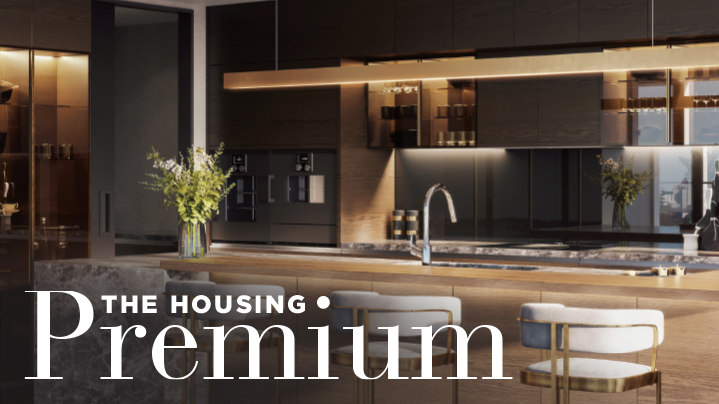The housing premium
With residential property choices informed by emerging technologies, local economic performance, and lifestyle trends that seemingly interchange like the seasons, Bayleys property reporter asks which property features consistently net premium prices?
In the wake of our latest global recession, it’s clear that the coronavirus pandemic is the catalyst for significant commercial and personal change – including change across New Zealand’s $55 billion residential property industry.
Giving many property owners pause for thought about their residential property choices, the coming months are expected to yield some interesting trends across the property market.
Where apartment dwellers may seek space after spending lockdown in urban centres, or rural residents scout a shift closer to friends, family, and services; certain property features endure - commanding higher premiums, no matter the market.
The waterfront premium
In its latest data release Bayleys’ global partner Knight Frank found waterfront properties across Australia commanded an average 63-percent premium on the sale price of their inland neighbours.
The Knight Frank Waterfront Index measures how much uplift a waterfront location adds to a property, with the research revealing the premium was greatest in Sydney – where there was up to 94-percent added value in the city’s waterfront communities.
Applying a similar methodology to some of Auckland’s waterfront neighbourhoods using unconditional sales data from the Real Estate Institute of New Zealand (REINZ), the waterfront neighbourhoods of St Mary’s Bay and Devonport were found to net more than a 100-percent premium on the average Auckland asking price last month.
This was $958,274 according to listings data from realestate.co.nz.
We can acknowledge some variables can influence a comparison between a waterfront neighbourhood and the city’s average asking price such as high-density development that traditionally has a lower sale value than a standalone home, therefore having a significant bearing on ultimate value.
But, what about when the waterfront locale is compared with a specific inland neighbour?
Properties sold last month in the eastern beach suburb of St Heliers, saw a 57-percent premium on those sold in neighbouring St Johns. Similarly, homes sold around Mangere Bridge netted a 93-percent higher price than those sold a couple of kilometres down the road in Mangere.
While the data illustrates a Kiwi love affair with waterfront property, Knight Frank Australia’s head of residential research Michelle Ciesielski explains in the report that not all waterfront homes are equal.
“This was reflected in the (Knight Frank Waterfront) Index with values varying in each (Australian) city, and by the type of waterfront,” she says.
Unsurprisingly, the Index found properties with harbour views (as opposed to coastal or riverside) netted the highest potential uplifts.
“Absolute waterfront properties on the harbour have the potential to push the premium up to as much as 97 percent,” Michelle says in analysis of the Australian data.
“Waterfront living is the ultimate lifestyle choice and this helps to underpin the value of these properties.
“Demand for super-prime waterfront property comes from a variety of buyers, ranging from an emotional purchase to a sole financial purpose. Such locations benefit from their appeal to families upsizing, or downsizers often moving within the local area or seeking a lifestyle change,” Michelle says.
While a waterfront lifestyle is thought to be healthier, happier, and more relaxing for its residents, modern families are also consistently willing to pay higher prices for homes in preferable school zones with access to other amenities.
The value of school zones
The system that requires students to live in a public school’s catchment zone to gain entry has long held influence on neighbourhood property prices, with parents willing to pay a premium for homes within zone of the best high-decile, high-performing state schools.
Where in January 2020, according to homes.co.nz, the median sale value in Auckland was $911,000, properties located within the ‘highest-value’ school zones secured an average upswing of about 70 percent when compared to ‘out of zone’ properties.
The highest value school zones at this time were; centrally-located Epsom Girls’ Grammar $1.8 million (97-percent premium); Glendowie College in the eastern bays $1.6 million (75-percent premium); the North Shore’s Takapuna Grammar $1.4 million (57-percent premium); and Selwyn College also in the eastern bays $1.4 million (54-percent premium).
Properties double-zoned for Auckland’s top boys’ and girls’ schools demand an even higher premium, with those affording access to both Auckland Grammar and Epsom Girls Grammar selling for more than double the city’s median at that time.
Interestingly, there’s a relationship between Auckland’s highest value school zones and a waterside position with all four of the premium school zones extending out the harbour, including properties at the water’s edge.
The Kiwi psyche
Where the latest design trends will come and go, influenced by international architecture and the ever-evolving technology space, an element of the Kiwi psyche comes into play when assessing the ‘premium effect’ in residential housing.
As an island nation with a deep affinity for the environment, it’s clear that New Zealanders value lifestyle above almost everything else.
Alongside properties offering an aspirational waterfront position and access to good schools, property purchasers are increasingly concerned with traffic flow and thus proximity, leading to consistent sale values across well-connected communities.
It seems that the property features consistently netting premium prices are quite simply those that add value to the residents and their lifestyle.
From sparkling sea views and beach access to quality education for children, time is all the more precious in a COVID-19 world, and those purchasing residential property increasingly understand that the home is much more than a financial asset – it’s an investment into your lifestyle.
Read more...
[Download PDF]